This post may contain affiliate links. Please see our disclosure policy.
Canning carrot soup is a delicious way to pressure can a smooth vegetable soup that’s ready to heat and eat right out of the jar. There aren’t very many canning recipes for pureed soups, and this is one of the few tested and canning approved recipes for home canners.

I absolutely love homemade carrot soup, and though it’s a simple recipe, I find it immensely satisfying. We’ll use rich bone broth as a base, and then add in carrots and spices to create something deeply nourishing.
Years ago, I found this heat and eat pressure canning recipe for carrot soup and I made it for some friends of mine living in a yurt with a sparse kitchen (and no refrigerator).
All they could do was heat simple meals on the wood stove, and a few jars of this simple soup made for easy meals after a long day out working the land.
Everything’s right in the jar, and there’s no need to puree the soup or add anything at all at serving.
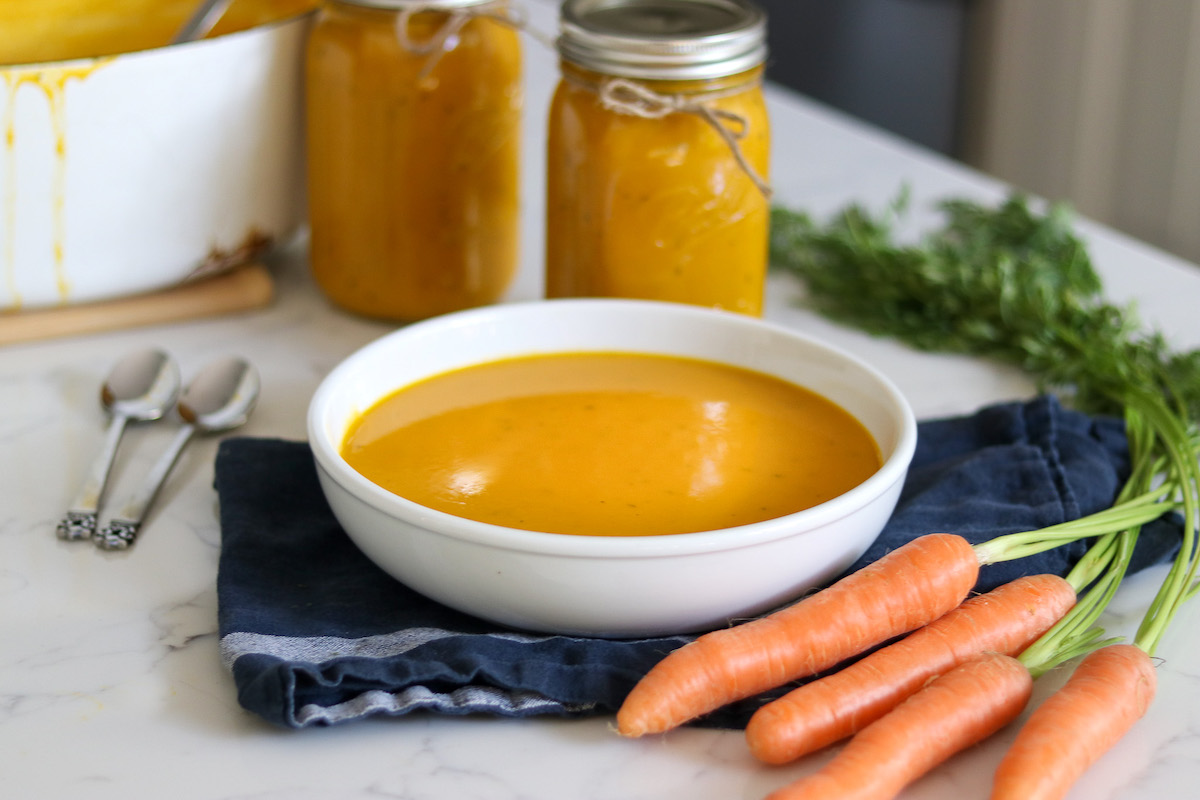
Are Pureed Soups Safe for Canning?
Most pressure canning recipes for soups are designed to put up chunks of vegetables and/or meat in a broth, and there are very few smooth or pureed soup recipes that are tested for home canning. Canning split pea soup is one of the exceptions, as it this pressure canning recipe for carrot soup.
It was tested by Ball Canning (or Bernardin, as they’re known outside the US) years ago. They used to have it listed on their “Fresh Preserving” website, but they’ve taken down most their “free” recipes now in favor of selling the many canning cookbooks they’ve put out in the past few years.
Those cookbooks don’t have much in terms of pressure canning recipes, because as you might imagine more people are excited about simple water bath canned jams and jellies these days.
Still, the pressure canning recipes are what puts food on the table, especially on busy weeknights, and I think it’s important to keep those already tested recipes freely available to anyone who wants to use them.
While this pureed soup is tested for canning, be aware that you still can’t add any “non canning safe” ingredients like flour, dairy, butter, etc. It is absolutely lovely topped with a few dollops of creme fraiche or sour cream, but that needs to be added at serving.
Likewise, I sometimes make a version with Thai spices and then serve it with a can of coconut milk mixed in. It’s delicious, but the coconut milk must be added at serving.
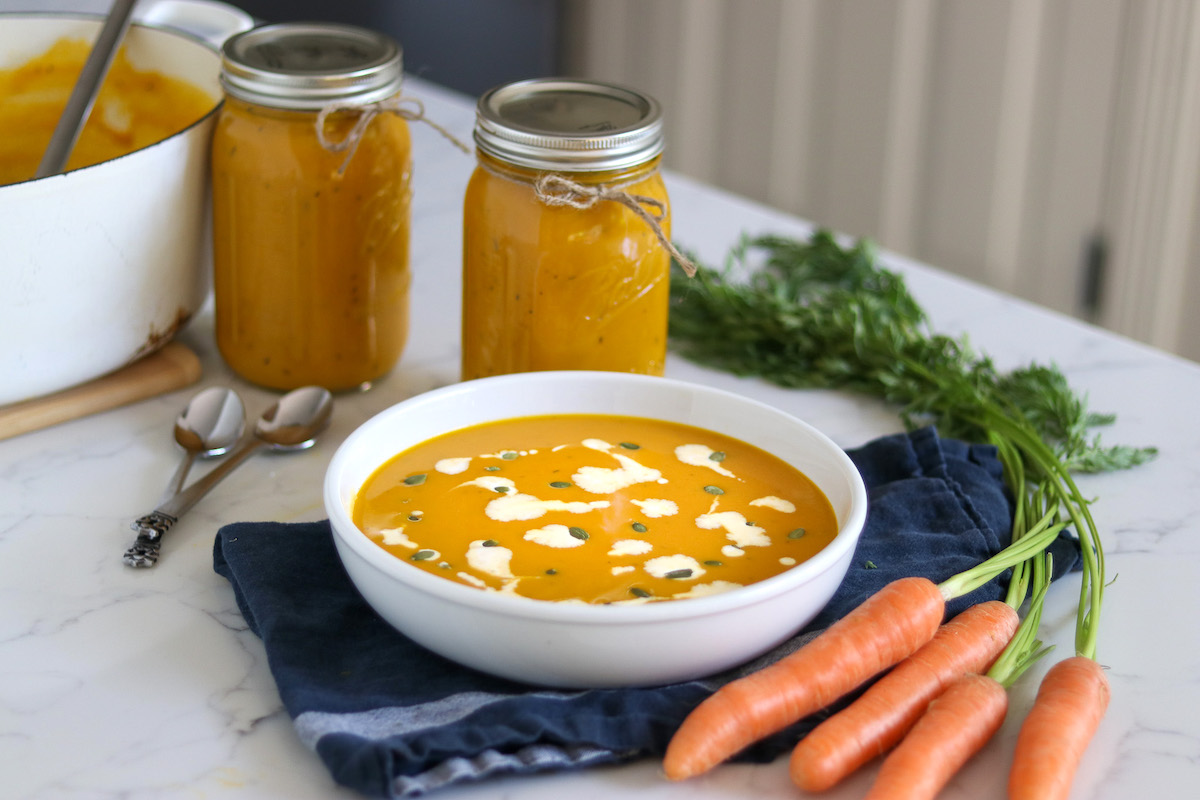
Ingredients for Canning Carrot Soup
The original tested recipe from ball canning was written as “Carrot and Fennel Soup.” It was listed on their fresh preserving website until 2018, and you can still see the original recipe if you look at a snapshot saved by the internet archive at that time.
To make 6 quarts or 12 pints, the recipe includes the following ingredients:
- 4 lbs carrots, peeled and sliced
- 2 bulbs fennel, sliced thin (about 1 cup)
- 1 Tbsp olive oil
- 6 cups vegetable stock
- 6 cups water (or more stock)
- 1/2 tsp white pepper
- salt to taste
Fennel, while delicious, is optional in this recipe. It adds a wonderful flavor, but it’s not nessisary for the recipe to be canning safe.
You can make a plain carrot soup if you like, or substitute celery or onions in place of the fennel. Those substitutions have been approved by Ball Canning.
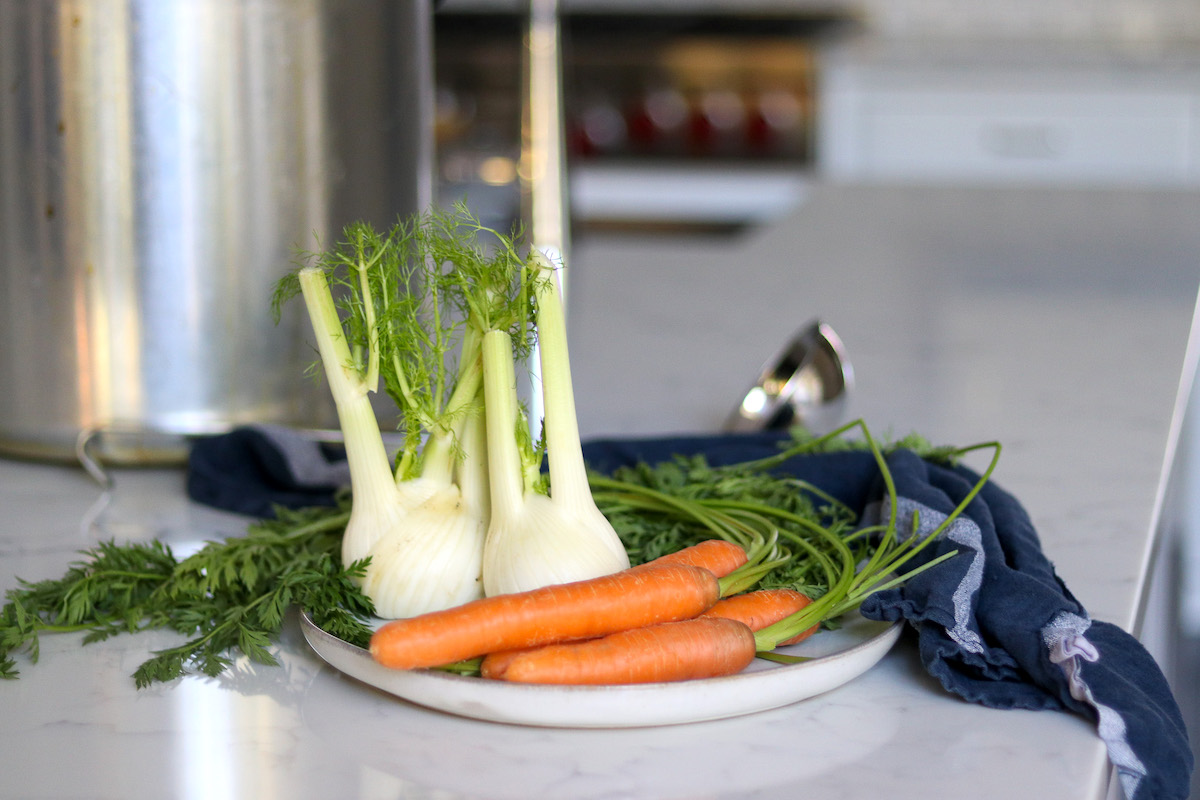
The original recipe uses half stock and half water, but I’d suggest using all stock for a better flavor. It says “vegetable stock” for a vegetarian soup, but you can also use any type of meat broth instead without impacting the total canning time. I prefer a chicken bone broth in this recipe.
As to spices, you’re always able to change the amounts or types of dry spices in a canning recipe, so long as you use reasonable amounts. That means you can add teaspoons or tablespoons of something, not cups of powdered spices that may make the mix too dry or dense. So keep it reasonable, and you’re fine. Whose adding cups of powdered anything anyway?
You’re also able to add adding reasonable amounts of things like Worcestershire sauce, vinegar, lemon juice and other salty or acidic liquid condiments. Things like a little bit of sugar, brown sugar, molasses or maple also work well.
Personally, I like adding a bit of Worcestershire sauce, a tablespoon or two of cider vinegar, a dollop of molasses and a savory green spices like thyme and sage. That creates a really hearty, well rounded soup with a bit of French inspired flavor.
I’ve also made this soup as a “Thai Carrot Soup” by adding red curry paste, lime juice and powdered ginger. It’s then served warmed with a can of coconut milk, which makes it extra rich and satisfying. (I’m particularly fond of Thai flavored canning recipes, as you’ll learn if you read my recipe for canning Thai Red Curry Duck.)
The website Healthy Canning suggests adding 1 teaspoon of onion powder, thyme, ginger, coriander, black pepper and 1/2 tsp of cumin, as well as 3 Tbsp lemon juice.
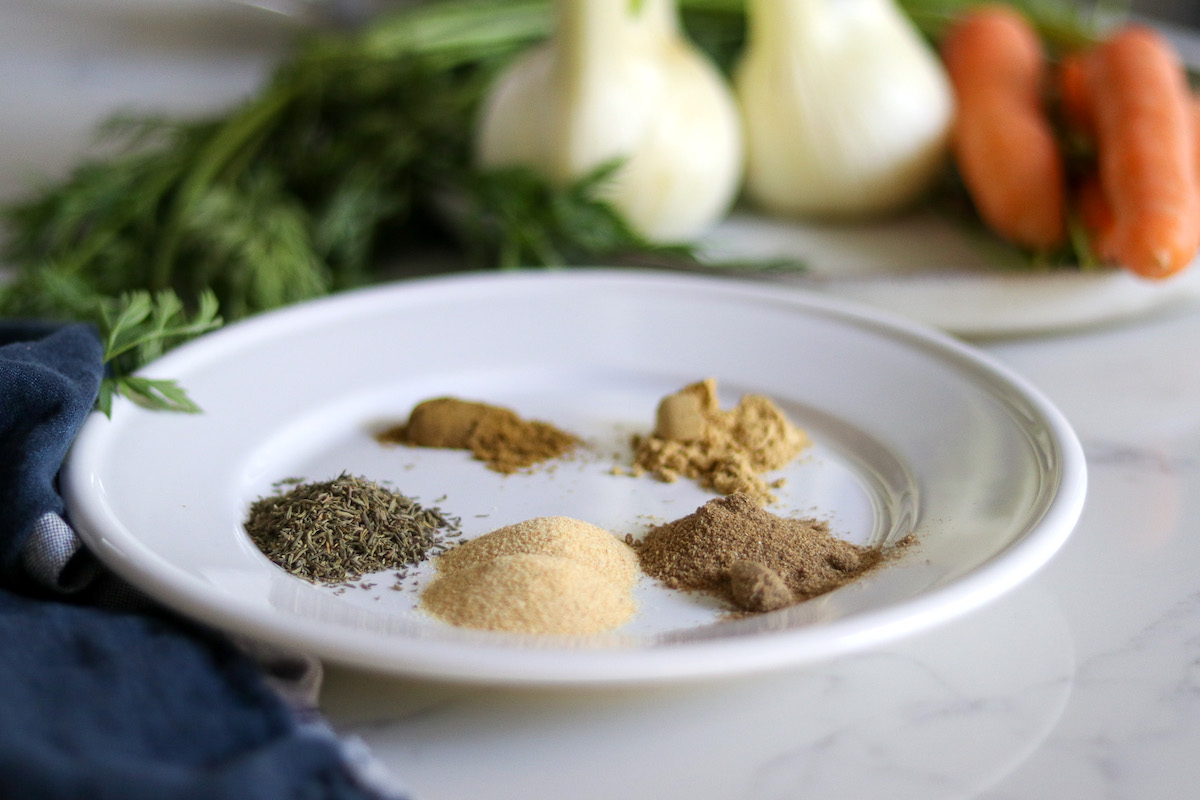
Preparing Carrot Soup for Canning
To make smooth carrot soup for canning, start by sauteing the fennel (or celery, or onion) in 1 tbsp of olive oil until tender (if using).
Peel and chop the carrots, and then add them to a large stock pot with 12 cups of water/stock. Add in the sauteed vegetables, if using.
Bring to a boil and cook until carrots are tender, about 15 to 20 minutes.

Once the carrots and other veggies are tender, it’s time to puree the soup.
You can use an immersion blender if you have one, or transfer the soup to a blender to puree. Be careful, it’s hot and can burn you here if you’re not paying attention.
After blending, place the soup back in the stock pot to be seasoned, and cook further before canning.

Once the soup is blended, it’s time to season to taste.
Ball canning just suggests a small amount of white pepper and salt to taste, but you can add whatever dry seasonings you choose here (in reasonable amounts).
The soup will be fully cooked before canning, so you’ll be able to taste it for both salt and seasoning. Be aware that some seasonings (ginger, cinnamon, cloves, cumin, etc) tend to intensify in canning, so use those sparingly.
After seasoning, simmer the pureed soup for an additional 30 minutes on the stove, adding water if it gets too thick.
While the soup is simmering, prepare your pressure canner because you’ll need it ready once the 30 minutes of simmering is over. Follow the manufacturer’s instructions for your variety of canner, as they’re all a bit different.
In most cases, the canner is prepped by adding a few inches of water to the bottom, putting in the bottom trivet and preheating it to a gentle simmer (around 180 degrees F).
Once the soup has simmered for 30 minutes, ladle it into prepared jars, either pints or quarts, leaving 1 inch headspace.
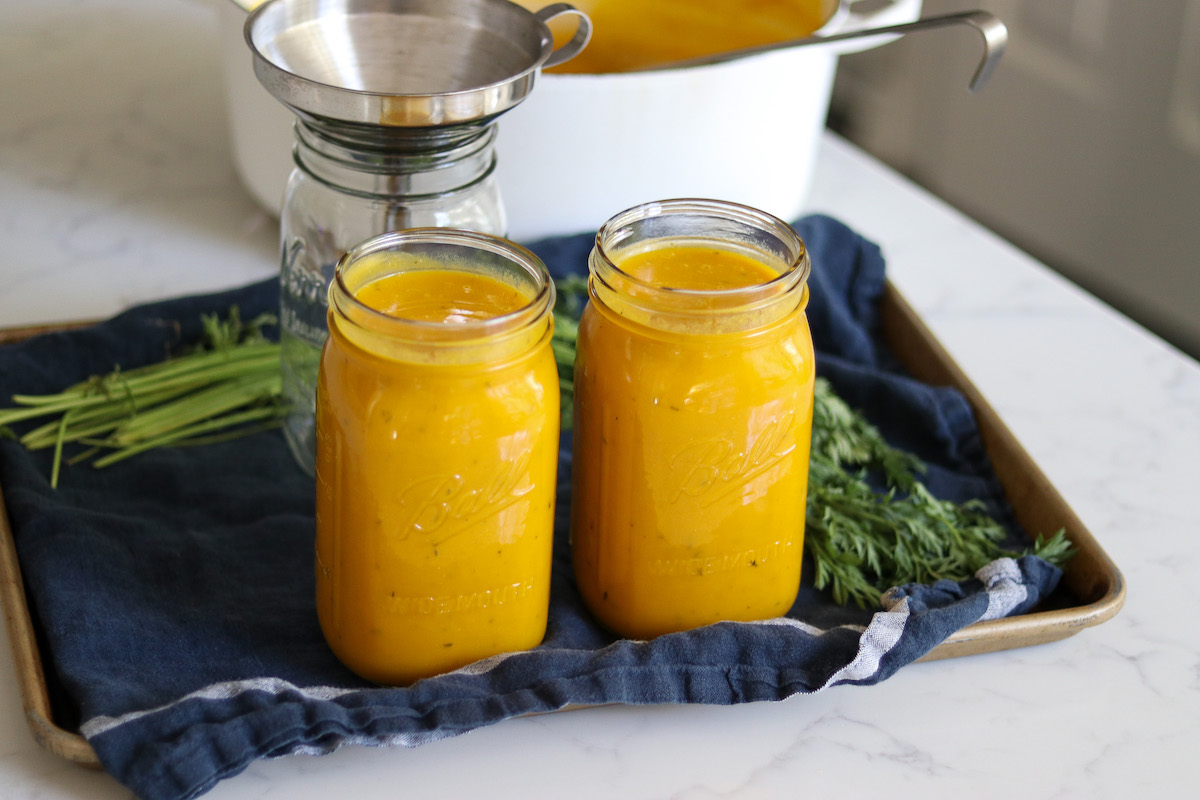 Once the jars are filled with hot soup, seal with 2 part canning lids to finger tight.
Once the jars are filled with hot soup, seal with 2 part canning lids to finger tight.
Load the jars into the canner and seal the lid. Follow the manufacturers instructions at this point, as all brands of pressure canners work slightly differently.
For my 30 Quart All American Canner, I tighten all the bolts and then allow the unit to steam out the vent pipe for 10 minutes before adding the canning weight. This ensures that the chamber is completely filled with steam and will heat to an even temperature (without any colder air pockets).
After steam release, I add the canning weight to the pressure appropriate for my altitude and then process for 40 minutes for pints or 50 minutes for quarts at 10 pounds pressure. (Adjusting pressure for altitude, see below)

Allow the canner to cool naturally before opening. Once cool, check jar seals and store any unsealed jars in the refrigerator for immediate use.
Properly pressure canned and sealed jars of carrot soup will maintain quality on the pantry shelf for 18 months, and be safe to eat for much longer provided they’re still sealed.
Refrigerate after opening.
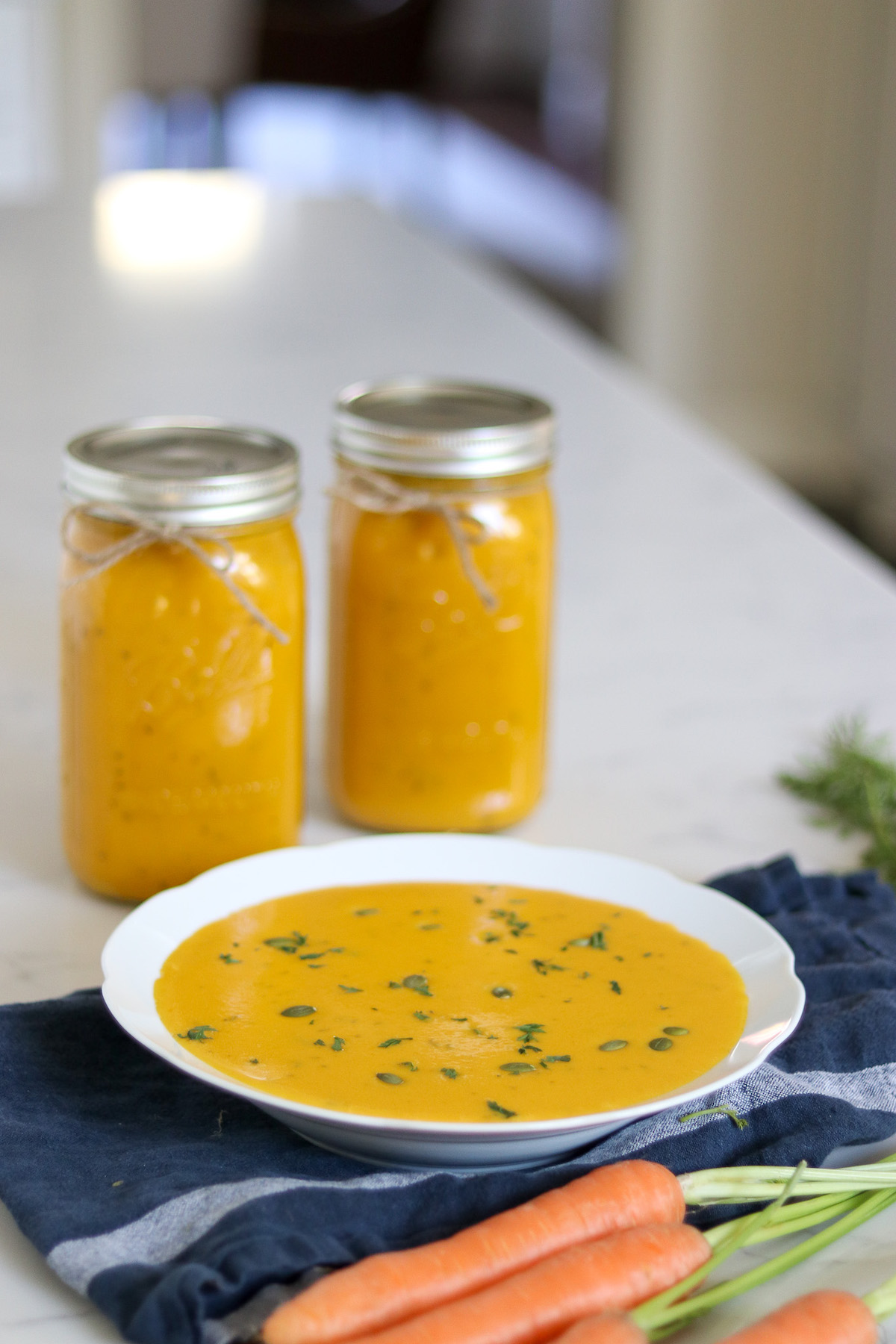
Altitude Adjustments
When pressure canning, the canning time always stays the same regardless of altitude. The thing you change is the canning pressure, and you use higher pressures at higher altitudes.
Altitude adjustments for pressure are as follows:
For dial gauge pressure canners:
- 0 to 2,000 feet in elevation – 11 lbs pressure
- 2,001 to 4,000 feet in elevation – 12 lbs pressure
- 4,001 to 6,000 feet in elevation – 13 lbs pressure
- 6,001 to 8,000 feet in elevation – 14 lbs pressure
For weighted gauge pressure canners:
- 0 to 1,000 feet in elevation – 10 lbs pressure
- Above 1,000 feet – 15 lbs pressure
Serving Home Canned Carrot Soup
To serve, open a jar and heat it in a saucepan or microwave.
It benefits from a dollop of creme fraiche or sour cream, and it’s also quite good with a bit of coconut milk or coconut cream warmed with the soup.
All of those are optional though, and it’s quite good as is. A sprinkling of diced herbs and/or pumpkin seeds works quite well if you want to get fancy too.
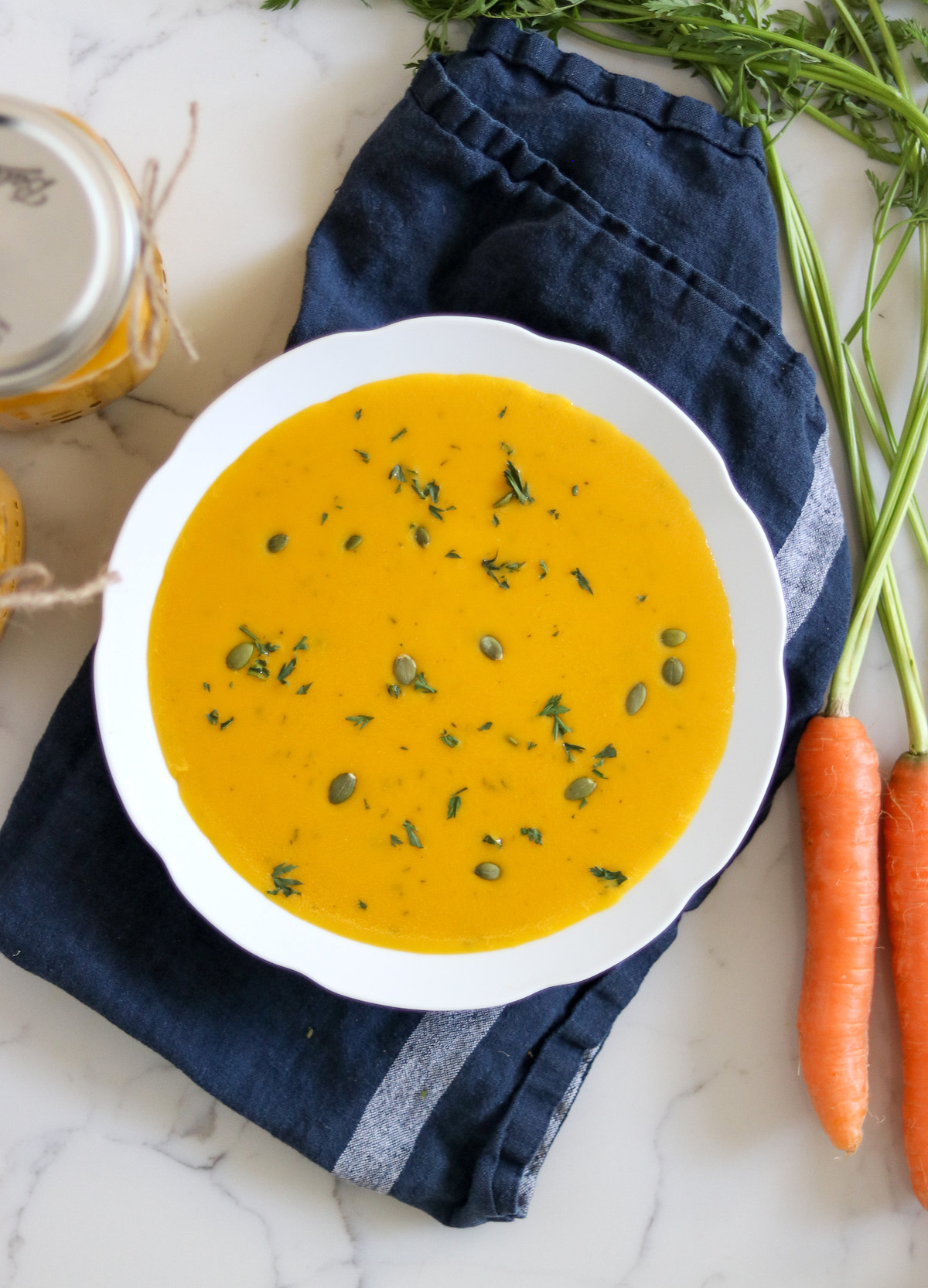 This tested recipe for canning carrot soup has been adapted from Ball Canning’s “Carrot and Fennel Soup” recipe. Lovely pictures in this post by Chez LaRae.
This tested recipe for canning carrot soup has been adapted from Ball Canning’s “Carrot and Fennel Soup” recipe. Lovely pictures in this post by Chez LaRae.
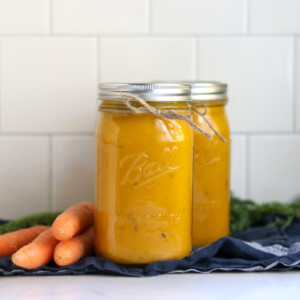
Canning Carrot Soup
Equipment
Ingredients
- 4 lbs carrots, peeled and sliced
- 2 bulbs fennel, sliced thin (about 1 cup) *see note
- 1 Tbsp olive oil
- 6 cups vegetable stock
- 6 cups water, or more stock*see note
- salt and pepper to taste
Instructions
- Slice the fennel (or onion/celery), if using.
- Saute the fennel in 1 Tbsp of olive oil until tender and translucent. (If using. You can also substitute celery or onion, but sautee them in this step as well.)
- Peel and chop the carrots.
- In a stock pot, add the water/stock, chopped carrots and sauteed vegetables. Bring to a boil and cook until tender, about 15-20 minutes. Turn off heat.
- Puree the soup until smooth, using an immersion blender or regular blender. Be careful here, soup is hot.
- Prepare the pressure canner at this point.
- Return the pureed soup to the stock pot, and add salt and seasonings of your choice. Simmer for an additional 30 minutes, adjusting seasonings and adding boiling water if the soup gets too thick.
- Ladle the soup into prepared jars, either pints or quarts, leaving 1 inch headspace.
- Seal wth 2 part canning lids to finger tight.
- Load the jars into your pre-heated pressure canner. Turn the stove up to high and vent steam for 10 minutes.
- Seal the canner and bring it up to pressure. When at pressure (see notes below), start timer and process the jars for 40 minutes for pints and 50 minutes for quarts.
- When the processing time is complete, turn off the heat and allow the canner to come to room temperature naturally.
- When cool, remove the jars from the canner and check seals. Store any unsealed jars in the refrigerator for immediate use.
- Properly pressure canned and sealed jars of carrot soup should
maintain quality on the pantry shelf for 18 months, and be safe to eat
much longer provided they're still sealed. Refrigerate after opening.
Notes
Altitude Adjustments
The canning time is always the same, 40 minutes for pints and 50 minutes for quarts, regardless of altitude. Pressure changes at higher altitudes. Altitude adjustments for pressure are as follows:For dial gauge pressure canners:
- 0 to 2,000 feet in elevation – 11 lbs pressure
- 2,001 to 4,000 feet in elevation – 12 lbs pressure
- 4,001 to 6,000 feet in elevation – 13 lbs pressure
- 6,001 to 8,000 feet in elevation – 14 lbs pressure
For weighted gauge pressure canners:
- 0 to 1,000 feet in elevation – 10 lbs pressure
- Above 1,000 feet – 15 lbs pressure
Nutrition
Nutrition information is automatically calculated, so should only be used as an approximation.
Vegetarian Soup Canning Recipes
Looking for more soup canning recipes?
Pressure Canning Recipes
Keep your pressure canning running with these simple pressure canning recipes!
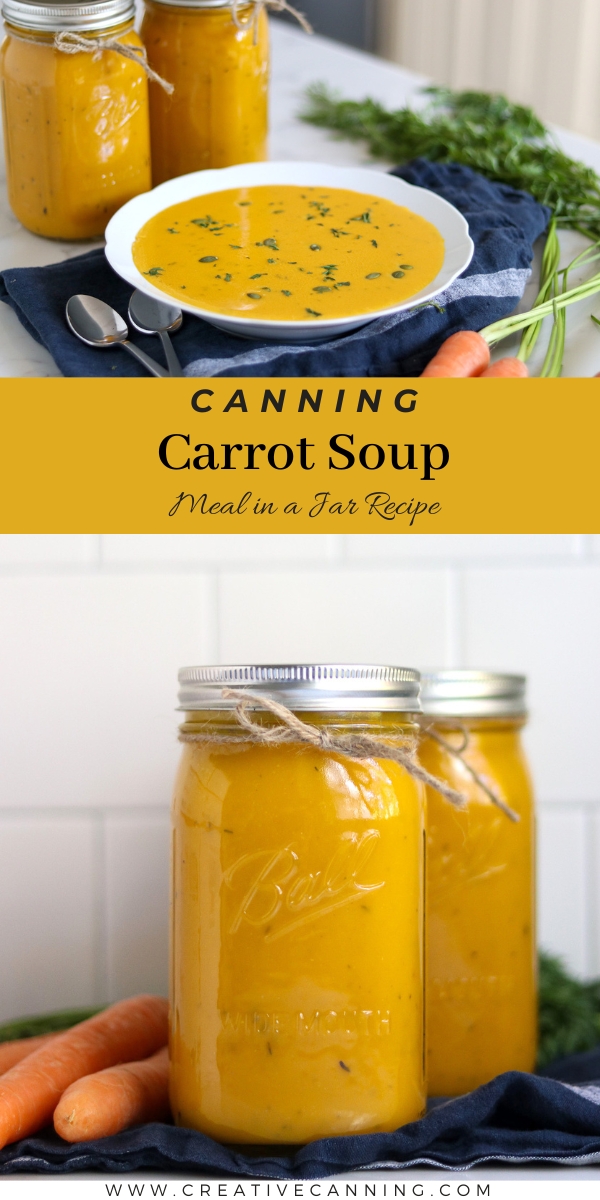
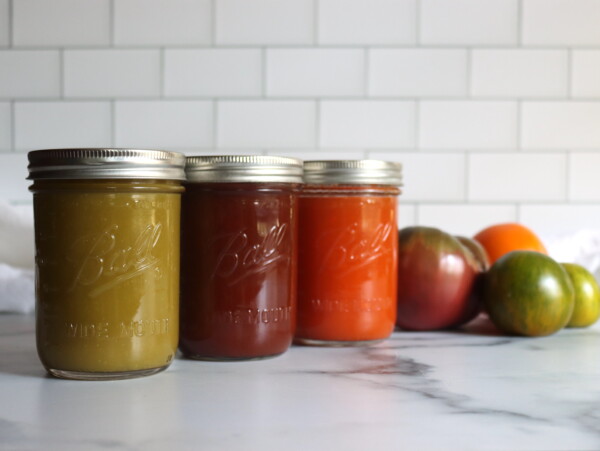
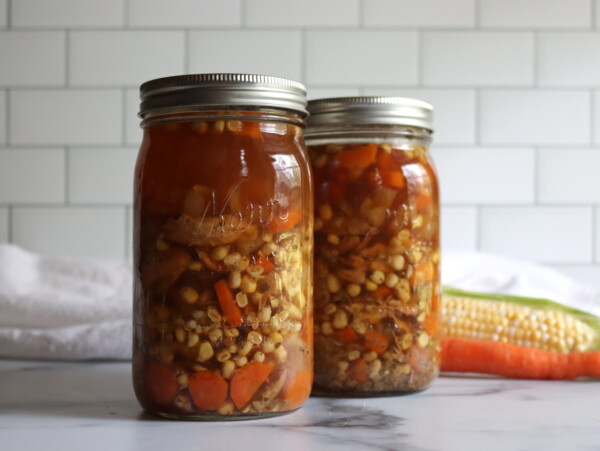
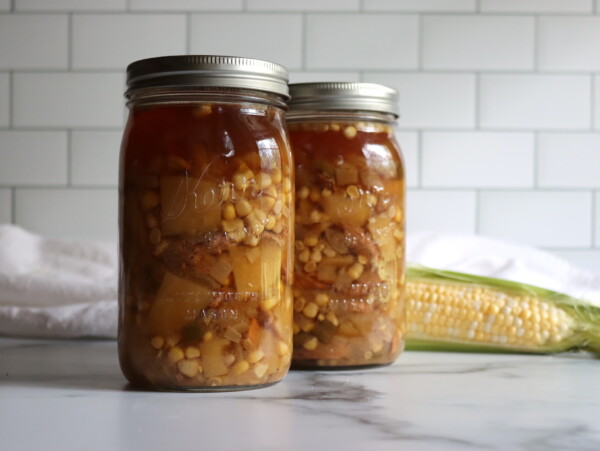
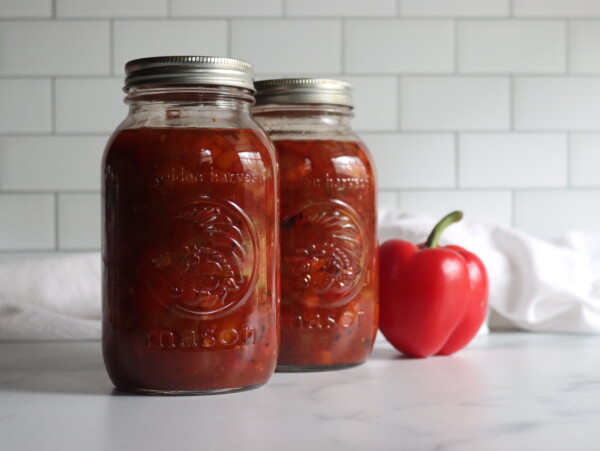
I made this carrot auto tonight! I used celery, yellow onion, and fresh garlic. My added spices: Chives, parsley, cilantro (all dried , from my garden last year). For dinner, I added some hald & half (not canned). It’s delicious.
My 1st batch is in my pressure cookery. Another batch will get cooked in the morning.
Hi, I just came across this recipe. Is it ok to roast the carrots in an oven for about 20 to 30 minutes when making this? I thought it might add some extra flavor.
That sounds amazing! If I were doing that, I’d add a cup of extra broth to the recipe to make up for the liquid lost in the carrots when roasting, just to make sure the soup doesn’t get too thick. But roasting them really would add a lovely flavor.
Excellent. I’ve made carrot-ginger soup many times, but I’ve always thought that when there’s enough ginger to be noticeable, it kind of overwhelms the carrots. I used two large fennel bulbs, two leeks, a very small chunk of ginger because I happened to have it in the fridge, about a tablespoon of salt, about a half teaspoon of white pepper, some lemon juice, and about a tablespoon of dried thyme, ground to powder in a mortar and pestle. I wouldn’t change a thing about those proportions (except I might try the Thai approach next time). Both the ginger and the fennel retreat to a nice supportive role and the carrots really stand out, which to me is the whole point.
I used the quantities as given and it came out to exactly six quarts, plus one little bowl for tasting, so that’s perfect. Total keeper recipe. I’d emphasize that, like any soup, a big part of what makes it good is the stock, so if possible, use a fully-flavored homemade one.
So glad you enjoyed it!
I was wondering if you could replace the fennel with leeks? They seem to be close in texture. I just have a lot of both carrots and leeks this year.
I would think so, they are quite similar and both are approved for canning. That said, the recipes is not specifically tested so you’ll have to use your best judgement there.